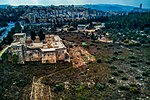Monastery of the Cross
All accuracy disputesChristian monasteries established in the 11th centuryChristian monasteries in JerusalemGeorgian Orthodox monasteriesGreek Orthodox monasteries ... and 2 more
Infobox religious building with unknown affiliationPages containing links to subscription-only content

The Monastery of the Cross (Arabic: دير الصليب, Dayr al-Salīb; Hebrew: מנזר המצלבה; Greek: Μοναστήρι του Σταυρού, Georgian: ჯვრის მონასტერი, jvris monast'eri) is an Eastern Orthodox monastery near the Nayot neighborhood of Jerusalem. It is located in the Valley of the Cross, below the Israel Museum and the Knesset.
Excerpt from the Wikipedia article Monastery of the Cross (License: CC BY-SA 3.0, Authors, Images).Monastery of the Cross
Haim HaZaz, Jerusalem Kiryat Shmuel
Geographical coordinates (GPS) Address External links Nearby Places Show on map
Geographical coordinates (GPS)
| Latitude | Longitude |
|---|---|
| N 31.7721 ° | E 35.208 ° |
Address
Monastery of the Cross
Haim HaZaz
9218812 Jerusalem, Kiryat Shmuel
Jerusalem District, Israel
Open on Google Maps









